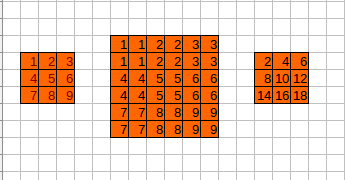本系列为darknet源码解析,本次解析为src/upsample_layer.h 和 src/upsample_layer.c 两个,sample_layer主要是构建上采样层, upsample_layer使用于yolo v3中;
upsample_layer.h 解析如下:
#ifndef UPSAMPLE_LAYER_H
#define UPSAMPLE_LAYER_H
#include "darknet.h"
// 构造上采样层
layer make_upsample_layer(int batch, int w, int h, int c, int stride);
// 上采样层的前向,反向传播函数
void forward_upsample_layer(const layer l, network net);
void backward_upsample_layer(const layer l, network net);
void resize_upsample_layer(layer *l, int w, int h);
#ifdef GPU
void forward_upsample_layer_gpu(const layer l, network net);
void backward_upsample_layer_gpu(const layer l, network net);
#endif
#endif下面一图解析如何进行上采样操作,输入特征图为3*3,通道数为1,上采样步幅为2,scale为1,前向操作与反向操作如下图:

upsample_layer.c的详细解析如下:
#include "upsample_layer.h"
#include "cuda.h"
#include "blas.h"
#include <stdio.h>
/**
* 构造上采样层
* @param batch 每个batch含有的图片数量
* @param w 图片高度
* @param h 图片宽度
* @param c 输入图像的Channel数量
* @param stride 步幅
* @return
*/
layer make_upsample_layer(int batch, int w, int h, int c, int stride)
{
layer l = {0};
l.type = UPSAMPLE; //层类别
l.batch = batch; // batch大小
l.w = w; //输入特征图的宽度
l.h = h; //输入特征图的高度
l.c = c; //输入特征图的通道数
l.out_w = w*stride; //输出特征图的宽度
l.out_h = h*stride; //输出特征图的高度
l.out_c = c; //输出特征图的通道数
if(stride < 0){ // 步幅小于0,想当于卷积操作
stride = -stride;
l.reverse=1;
l.out_w = w/stride; //输出特征图的宽度
l.out_h = h/stride; //输出特征图的高度
}
l.stride = stride; //步幅
l.outputs = l.out_w*l.out_h*l.out_c; // 上采样层对应一张输入图片输出元素个数
l.inputs = l.w*l.h*l.c; // 上采样层一张输入图片的元素个数
l.delta = calloc(l.outputs*batch, sizeof(float)); // 上采样层误差项(包含整个batch的)
l.output = calloc(l.outputs*batch, sizeof(float)); // 上采样层所有输出(包含整个batch的)
l.forward = forward_upsample_layer; // 上采样层的前向传播
l.backward = backward_upsample_layer; //上采样层的反向传播
#ifdef GPU
l.forward_gpu = forward_upsample_layer_gpu;
l.backward_gpu = backward_upsample_layer_gpu;
l.delta_gpu = cuda_make_array(l.delta, l.outputs*batch);
l.output_gpu = cuda_make_array(l.output, l.outputs*batch);
#endif
if(l.reverse) fprintf(stderr, "downsample %2dx %4d x%4d x%4d -> %4d x%4d x%4d\n", stride, w, h, c, l.out_w, l.out_h, l.out_c);
else fprintf(stderr, "upsample %2dx %4d x%4d x%4d -> %4d x%4d x%4d\n", stride, w, h, c, l.out_w, l.out_h, l.out_c);
return l;
}
void resize_upsample_layer(layer *l, int w, int h)
{
l->w = w;
l->h = h;
l->out_w = w*l->stride;
l->out_h = h*l->stride;
if(l->reverse){
l->out_w = w/l->stride;
l->out_h = h/l->stride;
}
l->outputs = l->out_w*l->out_h*l->out_c;
l->inputs = l->h*l->w*l->c;
l->delta = realloc(l->delta, l->outputs*l->batch*sizeof(float));
l->output = realloc(l->output, l->outputs*l->batch*sizeof(float));
#ifdef GPU
cuda_free(l->output_gpu);
cuda_free(l->delta_gpu);
l->output_gpu = cuda_make_array(l->output, l->outputs*l->batch);
l->delta_gpu = cuda_make_array(l->delta, l->outputs*l->batch);
#endif
}
// upsample_cpu(net.input, l.w, l.h, l.c, l.batch, l.stride, 1, l.scale, l.output);
void upsample_cpu(float *in, int w, int h, int c, int batch, int stride, int forward, float scale, float *out)
{
int i, j, k, b;
for(b = 0; b < batch; ++b){
for(k = 0; k < c; ++k){
for(j = 0; j < h*stride; ++j){
for(i = 0; i < w*stride; ++i){
int in_index = b*w*h*c + k*w*h + (j/stride)*w + i/stride; //输入特征图的位置
int out_index = b*w*h*c*stride*stride + k*w*h*stride*stride + j*w*stride + i; //输出特征图的位置
if(forward) out[out_index] = scale*in[in_index];// scale在cfg指定或者为默认值
else in[in_index] += scale*out[out_index]; //反转
}
}
}
}
}
/**
* 上采样层的前向传播
* @param l 当前上采样层
* @param net 整个网络
*/
void forward_upsample_layer(const layer l, network net)
{
// l.output = 0, 初始化为0
fill_cpu(l.outputs*l.batch, 0, l.output, 1);
if(l.reverse){ //下采样操作
upsample_cpu(l.output, l.out_w, l.out_h, l.c, l.batch, l.stride, 0, l.scale, net.input);
}else{// 上采样操作
upsample_cpu(net.input, l.w, l.h, l.c, l.batch, l.stride, 1, l.scale, l.output);
}
}
/**
* 上采样层的反向传播函数
* @param l 当前上采样层
* @param net 整个卷积层
*/
void backward_upsample_layer(const layer l, network net)
{
if(l.reverse){ //下采样操作的反向传播
upsample_cpu(l.delta, l.out_w, l.out_h, l.c, l.batch, l.stride, 1, l.scale, net.delta);
}else{ //上采样操作的反向传播
upsample_cpu(net.delta, l.w, l.h, l.c, l.batch, l.stride, 0, l.scale, l.delta);
}
}
#ifdef GPU
void forward_upsample_layer_gpu(const layer l, network net)
{
fill_gpu(l.outputs*l.batch, 0, l.output_gpu, 1);
if(l.reverse){
upsample_gpu(l.output_gpu, l.out_w, l.out_h, l.c, l.batch, l.stride, 0, l.scale, net.input_gpu);
}else{
upsample_gpu(net.input_gpu, l.w, l.h, l.c, l.batch, l.stride, 1, l.scale, l.output_gpu);
}
}
void backward_upsample_layer_gpu(const layer l, network net)
{
if(l.reverse){
upsample_gpu(l.delta_gpu, l.out_w, l.out_h, l.c, l.batch, l.stride, 1, l.scale, net.delta_gpu);
}else{
upsample_gpu(net.delta_gpu, l.w, l.h, l.c, l.batch, l.stride, 0, l.scale, l.delta_gpu);
}
}
#endif
完,
